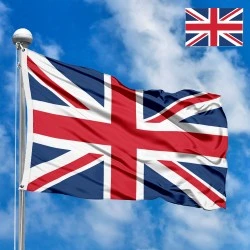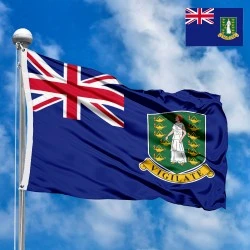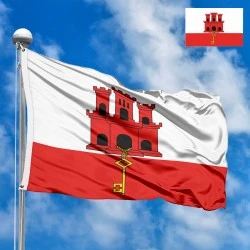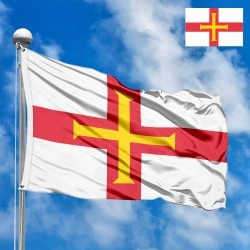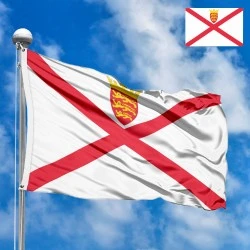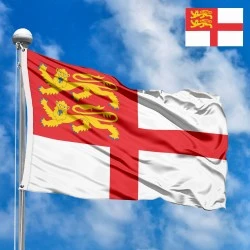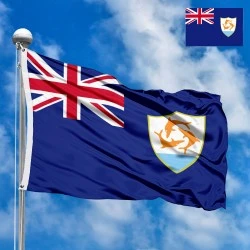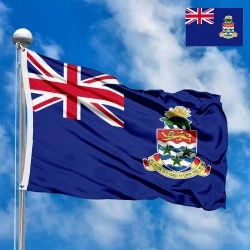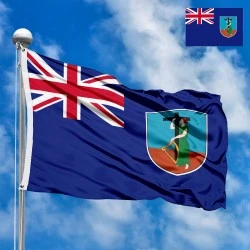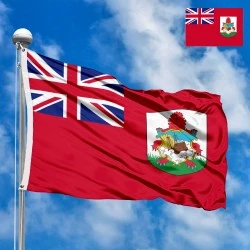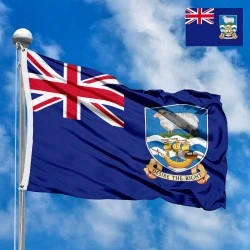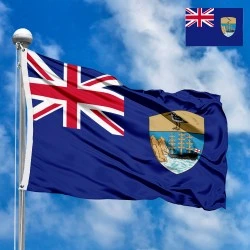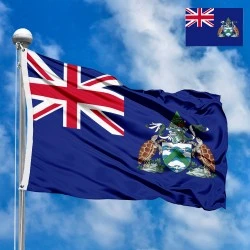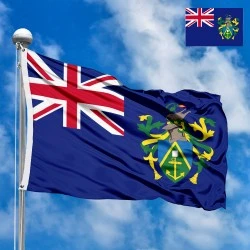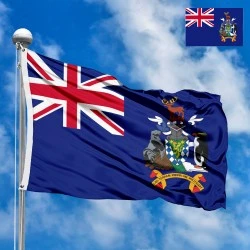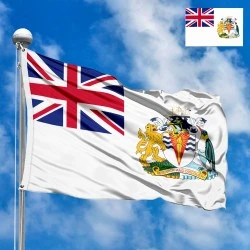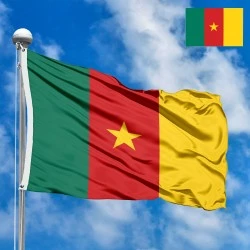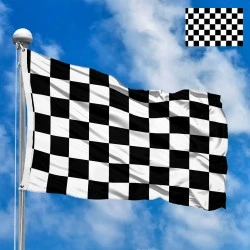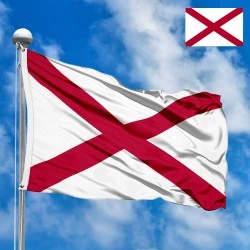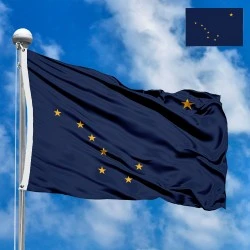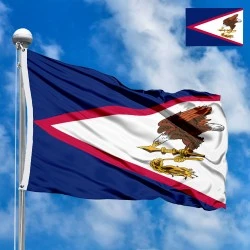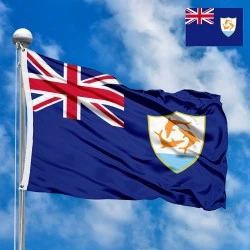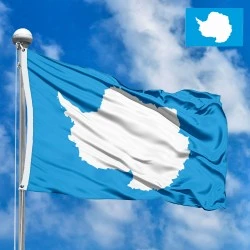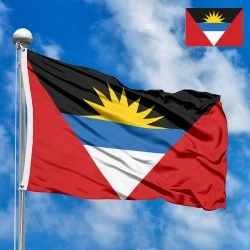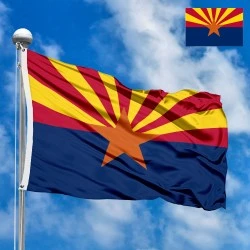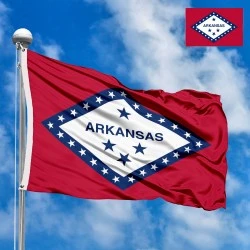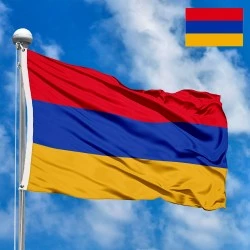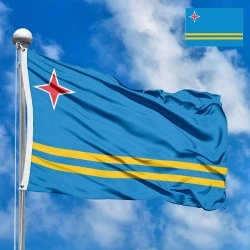Flag of Tristan da Cunha
- Flag Type: Regional
- Proportions (official): 1:2
- Official name: Tristan da Cunha
- Sovereignty (year): NO (British Overseas Territory)
- Country code, territory: SH, SHN, 654
- Capital: Edinburgh of the Seven Seas
- Population: ~250 (2024, estimate)
- Religions: Christianity
- Area (km²): 98
- Highest point: Queen Mary's Peak (2,062 m)
- Lowest point: Atlantic Ocean (0 m)
- Currency: Pound sterling (GBP, £), St. Helena pound (SHP, £)
- Languages: English
- Dialing code: +290
- National domain: .sh
Flag Information
General information
Demography and Culture
Economy and communications
- All Flags
- Flags of Countries by Continent
-
Flags of Organizations
- Flags of UN countries
- Flags of the European Union countries
- Flags of NATO countries
- Flags of the countries of the Organization of Islamic Cooperation
- Flags of the countries of the Organization of American States
- Flags of the Arab League countries
- Flags of the African Union countries
- Flags of the countries of the Union of South American Nations
- Flags of the Commonwealth of Nations
- Flags of the countries of the Secretariat of the Pacific Community
- Flags of the Nordic Council countries
- Flags of the Caribbean Community
- Flags of the countries of the Association of Southeast Asian Nations
- Flags of the East African Community
- Flags of the countries of the Organization of Turkic States
- LGBT Community Flags
- Historical Flags
- Ethnic Flags
- Flags of the USA (states)
Description
Tristan da Cunha, an isolated archipelago in the South Atlantic, boasts a unique and deeply symbolic flag that tells the story of its resilient community, rich natural environment, and enduring connection to the United Kingdom. More than just an official emblem, the flag serves as a powerful testament to the islanders' distinct identity and their proud heritage. This comprehensive description delves into every aspect of this captivating flag: its design, the profound meaning behind its colors and elements, its historical journey, its place in the world, and its profound significance for the inhabitants of this remote yet vibrant territory.
Design and Dimensions
The Flag of Tristan da Cunha is a distinctive Blue Ensign, a common flag design for British Overseas Territories. What sets it apart is the prominent display of the coat of arms of Tristan da Cunha positioned in the fly (the half of the flag furthest from the flagpole). The upper hoist (canton) features the universally recognized Union Flag, signifying its constitutional links to the United Kingdom.
-
Dimensions: Like most British ensigns, the flag of Tristan da Cunha adheres to a proportion of 1:2 (height to width). This standard ratio ensures visual harmony and proper display of its unique heraldic elements. The Union Flag in the canton also follows specific proportions to maintain its integrity within the overall design.
Symbolism of the Colors and Elements
Every component of the Tristan da Cunha flag is imbued with local significance, reflecting the island's unique environment, history, and the way of life of its people:
-
Blue Field: The expansive blue field of the ensign unequivocally represents the vastness of the South Atlantic Ocean that surrounds Tristan da Cunha. It symbolizes the islands' extreme isolation, their deep reliance on the sea for sustenance and connection with the outside world, and the challenges and opportunities presented by their maritime environment.
-
The Union Flag (Canton): The inclusion of the Union Flag in the canton serves as a clear and unwavering declaration of Tristan da Cunha's status as a British Overseas Territory. It symbolizes the islands' political allegiance to the United Kingdom, the historical legacy of British exploration and settlement, and the ongoing protection and governance provided by the Crown. For the islanders, it often represents a sense of stability and belonging to a broader community.
-
The Coat of Arms (Fly Side): The coat of arms of Tristan da Cunha is a meticulously designed heraldic device, rich with local and natural symbolism:
-
The Shield: The central shield is divided into four quarters. The field is a vibrant blue, echoing the ocean, and features two white albatrosses (often stylized) in flight. These magnificent birds are endemic to the Tristan da Cunha group and symbolize the islands' incredible biodiversity and their importance as a nesting ground for numerous seabird species. Below the albatrosses, two yellow/gold Tristan rock lobsters (crayfish) are depicted, representing the island's crucial fishing industry, which is the cornerstone of its economy and a vital food source. The lobster is also a symbol of local sustenance and tradition.
-
Four White Lozenge-Shaped Figures: These abstract shapes, often referred to as diamond or lozenge shapes, are not explicitly defined in some heraldic descriptions but are commonly interpreted as representing islands. Given the archipelago consists of several islands (Tristan, Nightingale, Inaccessible, Gough), this interpretation makes strong geographical sense, symbolizing the distinct landmasses within the territory.
-
The Crest (Tristan Longboat): Above the shield, resting on a wreath of blue and white, is a Tristan longboat (or dinghy). This is an iconic symbol of the islanders' traditional way of life, their seamanship, and their connection to the sea. These unique, locally built boats have historically been essential for fishing, inter-island travel, and landings on the rugged coastline. It represents the self-sufficiency, hard work, and maritime heritage of the Tristanians.
-
The Motto: The motto "Our Faith is Our Strength" is inscribed below the shield. This powerful phrase profoundly reflects the deeply religious nature of the community (primarily Anglican), their unwavering faith, and the inherent resilience required to thrive in such an isolated and often challenging environment. It speaks to the spiritual fortitude that has sustained generations of islanders.
-
History of Creation and Adoption
For most of its history, Tristan da Cunha was administered as a dependency of Saint Helena, sharing its flags and symbols. The distinct identity of Tristan da Cunha gradually developed, and with it, a desire for its own unique emblematic representation.
The current flag of Tristan da Cunha was officially adopted on October 20, 2002. This was a significant milestone, marking a moment of increased autonomy and self-recognition for the island. Prior to this, the island used the flag of Saint Helena. The creation of the unique coat of arms, which is the central feature of the flag, was approved by Queen Elizabeth II in 2002, paving the way for its inclusion on the Blue Ensign. This adoption was part of a broader trend among British Overseas Territories to develop their own distinct symbols, reflecting their unique heritage and aspirations while maintaining their constitutional links to the UK. The design process involved consultation with the islanders to ensure that the chosen symbols accurately represented their culture and environment.
Country, Region, and Acceptance
Tristan da Cunha is an integral part of the British Overseas Territory of Saint Helena, Ascension and Tristan da Cunha. It is geographically located in the South Atlantic Ocean, approximately 2,400 kilometers (1,500 miles) south-southwest of Saint Helena and about 2,800 kilometers (1,700 miles) from South Africa. Its extreme isolation has earned it the title of the "most remote inhabited archipelago in the world."
The flag is universally accepted as the official emblem of Tristan da Cunha by its inhabitants, by the British government, and by international bodies. It is proudly flown at official buildings, at the harbor, and during community events, symbolizing the island's unique status within the global community and its specific administrative identity under the British Crown.
Significance for the Inhabitants
For the roughly 250 permanent residents of Tristan da Cunha, the flag is far more than just a piece of cloth; it is a profound symbol of their identity, resilience, and unique way of life:
-
Sense of Identity and Belonging: The flag is a powerful visual representation of their distinct identity as "Tristanians." It fosters a strong sense of belonging to their isolated home and reinforces their shared cultural heritage.
-
Pride in Heritage: The symbols on the flag — the albatrosses, the rock lobsters, and especially the longboat — evoke deep pride in their maritime history, their self-sufficiency, and their ability to thrive in such a challenging environment. It celebrates their unique traditions and unbreakable spirit.
-
Symbol of Faith and Resilience: The motto, "Our Faith is Our Strength," resonates deeply with the islanders, who have historically faced and overcome immense challenges, including volcanic eruptions and extreme weather. It underscores their unwavering religious belief and their incredible collective resilience.
-
Connection to Nature: The natural elements on the flag, particularly the albatrosses and lobsters, highlight the islanders' profound connection to their natural environment and their dependence on its resources. It also reflects their commitment to the conservation of their unique ecosystem.
-
Expression of Autonomy: The adoption of their own distinct flag represented a significant step towards greater self-recognition and autonomy within the broader British Overseas Territory, giving them a visible symbol of their unique place in the world.
Interesting Facts
-
World's Most Remote Inhabited Island: Tristan da Cunha holds the distinction of being the most remote inhabited archipelago in the world, making its flag a symbol of extreme isolation and remarkable human perseverance.
-
Unique Longboats: The Tristan longboat on the crest is a specific type of boat unique to the island, traditionally built by the islanders themselves, highlighting their resourcefulness and craftsmanship.
-
Volcanic Origin: The main island is a volcanic island, with a central peak, Queen Mary's Peak, reaching over 2,000 meters. The last major eruption in 1961 forced the evacuation of the entire population to the UK. The islanders' subsequent decision to return in 1963 speaks volumes about their attachment to their homeland, a sentiment echoed by the flag's symbolism.
-
Albatross Haven: The islands of Tristan da Cunha and Gough Island are critical breeding grounds for several species of albatross, including the Tristan albatross, one of the rarest seabirds in the world.
-
Lobster Fishing: The rock lobster industry is the mainstay of the island's economy, underscoring the importance of this symbol on the flag.
-
Small Population: With a population of around 250, Tristan da Cunha is one of the smallest and most tightly knit communities on Earth, where the flag unites them.
-
No Airport: Due to its rugged terrain, Tristan da Cunha has no airport. Access is solely by sea, via fishing vessels and research ships, further emphasizing its isolation.
-
Single Surname Origins: Historically, the island's population grew from a very small number of founding families, leading to a limited number of surnames that still dominate the island today, fostering a unique family-like community.
-
Simple Yet Profound Motto: The motto "Our Faith is Our Strength" is remarkably simple yet incredibly profound, perfectly encapsulating the spirit of survival and belief that defines the Tristanian people.
In the demonstration images, full-size flags are shown with proportions of 2:3, and hand-held flags with proportions of 1:2.
Donation
Download
Completely free for commercial and non-commercial use (public domain).
You can freely use them in your news magazines, websites, software, mobile applications.
We appreciate a backlink to https://flagssite.com
Raster files - Flag of Tristan da Cunha (PNG, JPG)
 Waving flag
Waving flag
- PNG format (transparent background), 72dpi, dimensions in Pixels (px), aspect ratio 3:4.
- 15х20 px
- 30х40 px
- 60х80 px
- 120x160 px
- 240x320 px
 Sizes:
Sizes:
"v15" - image size (by height); if necessary, replace with available: v15, v30, v60, v120, v240.
!!! For resizing, use the Latin (eng) keyboard layout.
<img src="https://flagssite.com/flags/v15/20457.png" alt="Flag of Tristan da Cunha">
 Round flag
Round flag
- PNG format (transparent background), 72dpi, dimensions in Pixels (px), aspect ratio 1:1.
"d15" - image size (diameter); if necessary, replace with available: d15, d30, d60, d120, d240.
!!! For resizing, use the Latin (eng) keyboard layout.
<img src="https://flagssite.com/flags/d15/20457.png" alt="Flag of Tristan da Cunha">
 Rectangular flag 2:3
Rectangular flag 2:3
- JPG format, 72dpi, dimensions in Pixels (px), aspect ratio 2:3.
"h30" - image size (by height); if necessary, replace with available: h15, h30, h60, h120, h240, h360, h480.
!!! For resizing, use the Latin (eng) keyboard layout.
<img src="https://flagssite.com/flags/h30/20457.jpg" alt="Flag of Tristan da Cunha">

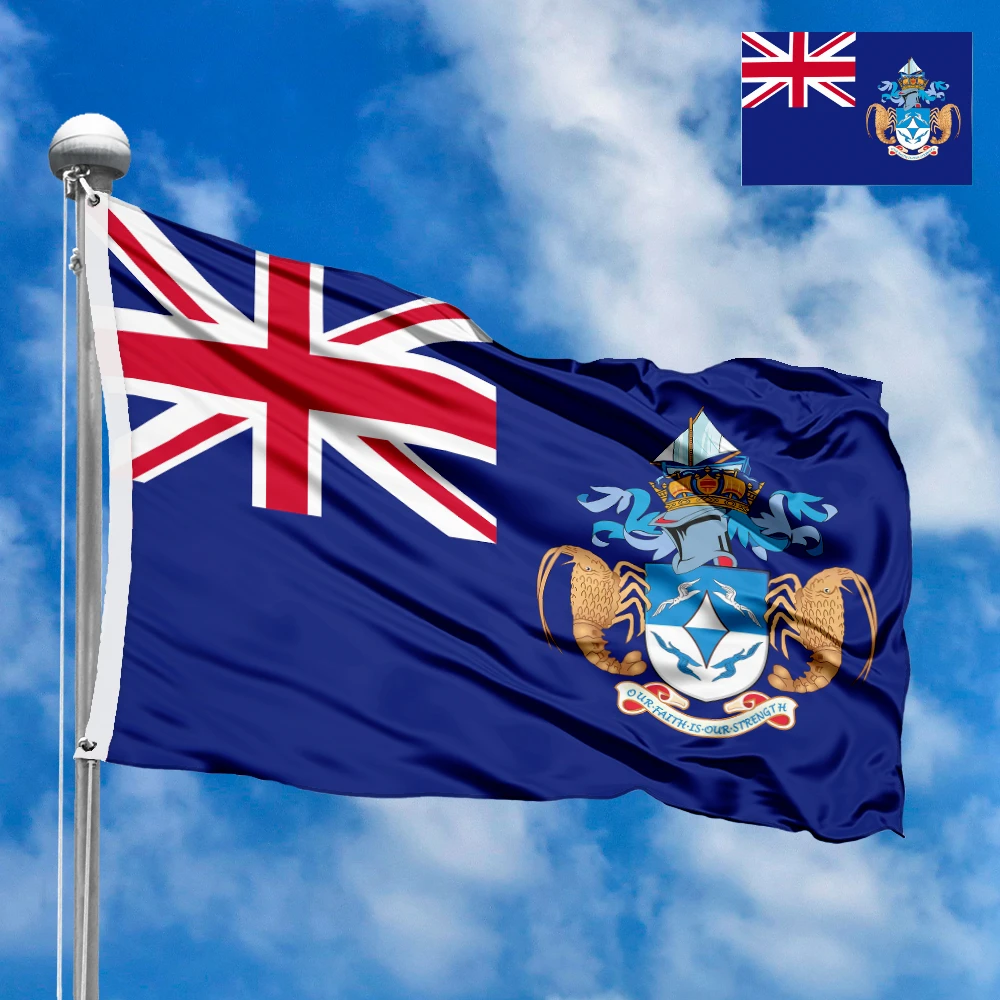
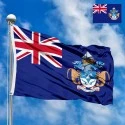
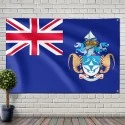


 Sizes:
Sizes:
 Sizes:
Sizes:
